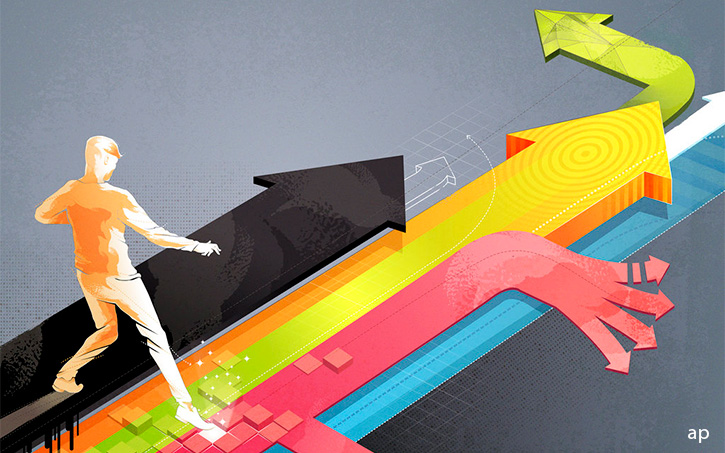
In the first quarter of 2024, the European assets of exchange-traded funds (ETFs) and exchange-traded commodities (ETCs) reached a record level of 1.81 trillion euros, up 10 per cent from the end of 2023. But which trends are likely to characterise the development of the market in the coming months? We have identified five:
- Will investors move on from US equities?
- How will divergent monetary policies affect bond ETFs?
- Will defence still drive interest in thematic ETFs?
- Gold could make ETCs shine
- The consequences of iShares' entry into the active ETF segment
The assets of European ETFs and ETCs (in EUR billion)

1. Will investors move on from US equities?
In the first quarter, European equity ETFs raised 36.8 billion euros, up slightly from 36.4 billion at the end of 2023, a sign that investors' confidence in the stock market is up. In particular, they sought to profit from US stocks's rally through both dedicated and international equity ETFs. In the latter, the weighting of the US market can be as high as 70%.
According to Morningstar analysts, the US stock market is overvalued by 3%. How long can it continue its run? David Sekera, market strategist at Morningstar, recently warned that "what has worked over the past year and a half is unlikely to continue to do so in the future" and that consequently it is time for "contrarian choices."
Looking at the statistics of flows into ETFs, one wonders whether these contrarian choices might be-- probably not European equities, which were the hardest hit by outflows in the first quarter. While no longer cheap at a price/fair value ratio of 1.05, they appear less overvalued than US stocks. Other contrarian alternatives could be value stocks or small caps.
The best and worst equity ETFs categories in Q1
2. How will divergent monetary policies affect bond ETFs?
In the first quarter, bond ETFs experienced a decline in investment flows from 14.1 billion euros in the last three months of 2023 to just 8.8 billion. "The slowdown, which was particularly pronounced in February and March, was due to the scaling back of rate-cutting expectations by the US Federal Reserve in particular," explains José Garcia-Zarate, associate director of passive strategies research at Morningstar. "Investors are now pointing to the European Central Bank (ECB) to take the initiative to cut rates before the Fed does."
In this climate, investors have taken a rather cautious stance by favouring bond funds with ultra-short maturities hedged against exchange rate risk, in order to take advantage of the still-high interest rates, without taking too much risk on future central bank moves.
In the coming months, the situation could change as an ECB rate cut in June becomes increasingly likely, after the central bank left them unchanged at its April meeting. On the other hand, the likelihood of the Fed acting soon has diminished since the release of March's inflation data.
3. Will defence drive thematic ETFs again?
One of the main surprises of the first quarter concerns thematic ETFs. There, the theme of technology, despite an ongoing AI revolution, was outweighed by what Morningstar calls 'social' themes, including trends like consumer spending, demographics, and the business of wellness. But it was not any of these themes that took the top spot in investors' interest but rather that of security, including defence sector ETFs, which captured some €548.4 million in the first half of the year.
The figure is less surprising considering the rally in defence stocks over the past two years, which led Goldman Sachs to describe some big names in the industry as overvalued earlier this month. It remains to be seen whether the sector will still be able to benefit in the coming months from the evolving situation in Eastern Europe, the Middle East and East Asia.
4. Gold could make ETCs shine
Commodities ETFs and ETCs suffered outflows of 2.1 billion euros in the first quarter, following on from the nearly EUR 5 billion that went out at the end of last year. Much of this was attributable to instruments on precious metals, particularly gold, despite the fact that the price rose to $2,200 per ounce in March. Retail investors may well return to buying gold ETCs in the coming months, partly as a defensive measure in the face of rising geopolitical risk and ahead of the US election cycle.
Peter Kinsella, Global Head of Forex Strategy at Union Bancaire Privée (UBP) points to increasing flows into the gold market. In particular, "there has been a notable increase in long futures positioning, suggesting that institutional investors have increased their exposure to the yellow metal," said Kinsella, who also points to an increase in retail investors, though lagging behind most of the uptrend. "This broadening of the investor base implies that the rally is still ongoing. We note that retail investors remain underinvested relative to historical averages," the strategy added.
5. The consequences of iShares' foray into active ETFs
In the coming months, ETF investors will also do well to monitor developments in the active ETF segment in Europe. In March, Blackrock-owned iShares entered this market with two income-oriented equity replicants.
"This marks the arrival of the largest ETF issuer in Europe in this growing corner of the market, where JP Morgan remains the leading player with a 44 per cent share," according to Morningstar's Garcia-Zarate.
Flows in European active ETFs by asset class

In the first quarter, active ETFs raised around 2.1 billion euros, up from 1.05 billion at the end of 2023, and assets reached 33.6 billion euros. This type of index fund continues to represent a niche in the European market at about 1.9 per cent of total assets, but they seem to fit the needs of investors who want to take advantage of ETFs as wrappers for active strategies at typically lower costs than traditional funds.
This story was originally published in Italian on April 26.





























